Table of Contents
-
Pinterest’s Evolution: From Simple Pinning to Shopping Powerhouse
-
Real Brand Success Stories That’ll Make You Rethink Your Strategy
-
Building Your Pinterest Marketing Framework From Scratch
-
Integrating Pinterest Into Your Existing Marketing Mix
-
Case Study Analysis: How to Learn From Others’ Wins and Losses
-
Final Thoughts
TL;DR
-
Pinterest completely flipped the script from a social platform into a visual search engine and shopping destination, creating new money-making opportunities for businesses
-
Fashion brands are seeing 3-5x higher conversion rates on Pinterest compared to other social platforms through smart product pin optimization
-
B2B companies are crushing it by focusing on educational infographics and industry insights instead of boring corporate content
-
Vertical pins (2:3 aspect ratio) with clear text overlays get 2-3x higher engagement rates than standard social media formats
-
Pinterest users plan purchases 45-90 days ahead of time, so you need to publish seasonal content months before everyone else is even thinking about it
-
Converting blog content into Pinterest-optimized graphics can boost website traffic by 200-400% when you nail the keyword targeting
-
Pinterest advertising needs smaller daily budgets than Facebook or Google Ads but takes way longer to optimize for stable performance
With 89% of users utilizing the platform for purchase inspiration according to Sprout Social, Pinterest has clearly evolved way beyond simple mood boards into a serious money-making machine that smart businesses can’t afford to ignore.
Pinterest’s Evolution: From Simple Pinning to Shopping Powerhouse
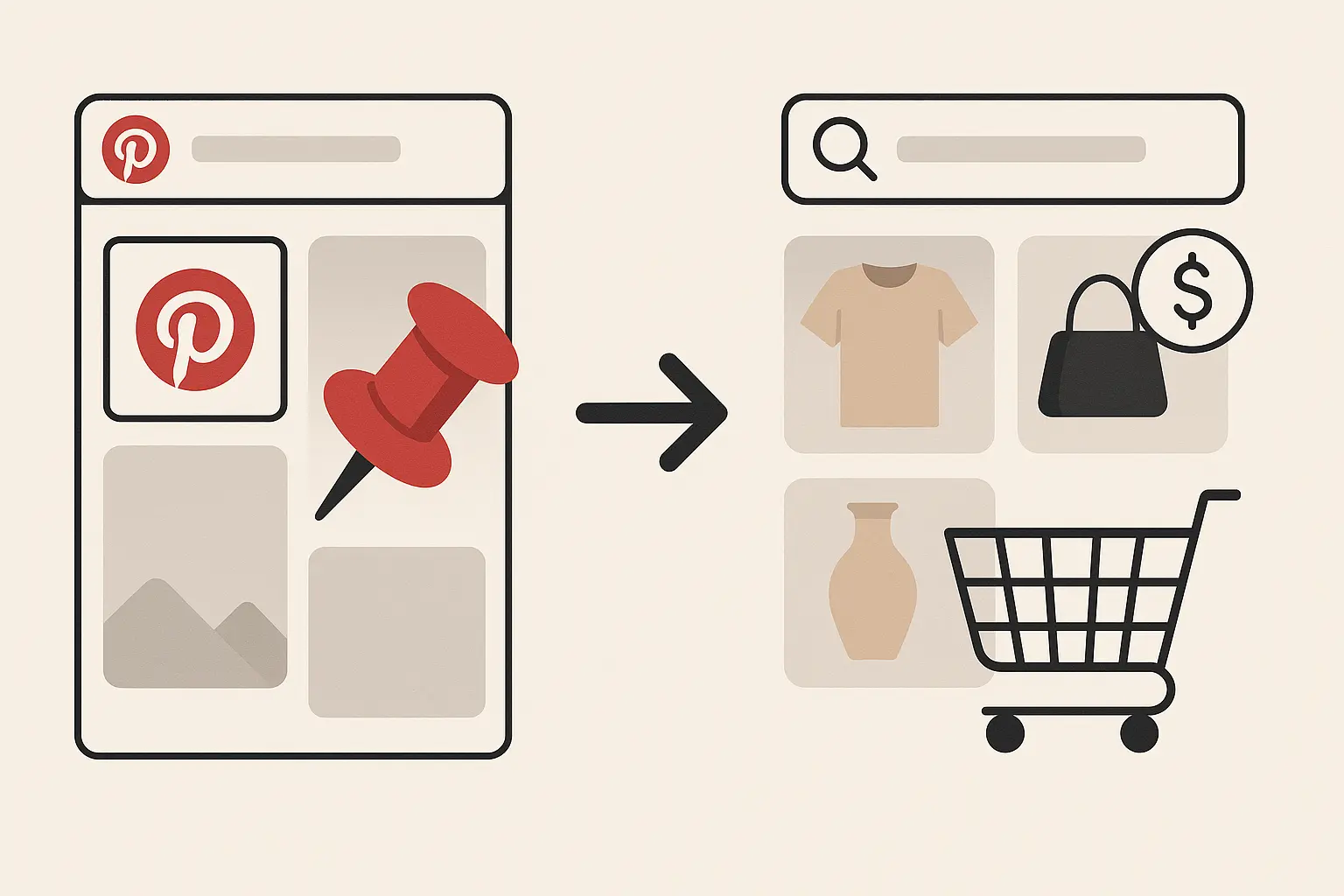
How Pinterest Became a Visual Search Engine (Not Just Another Social Platform)
I’ll be honest – I was skeptical when Pinterest first started changing. But after working with dozens of clients over the past three years, I’ve seen firsthand how this transformation is making businesses serious money.
Pinterest ditched its original mood board identity and rebuilt itself as a visual search engine with serious shopping capabilities. This completely flips the script on how you need to think about Pinterest marketing.
Here’s the thing though – users don’t come here to scroll through friends’ updates or watch viral videos. They show up with purchase intent and a planning mindset, actively searching for solutions, inspiration, and products to buy.
Pinterest has gotten really smart about showing people what they actually want to see. It prioritizes fresh content, analyzes user engagement patterns, and identifies signs that someone’s ready to buy something. Your content strategy needs to focus on being discoverable and commercially valuable, not just pretty pictures that get likes.
According to Sprout Social, Pinterest’s been growing like crazy – up 23.2% year-over-year as of January 2024, making it the second fastest-growing social media platform after Instagram. That growth comes from users who want to find and buy things, not just browse casually.
If you don’t get how these algorithm changes work, you’re basically throwing spaghetti at the wall and hoping something sticks. Understanding these shifts is crucial for developing high-impact content strategies that align with Pinterest’s search-driven approach and what users actually want.
The platform now rewards content that serves user search intent and demonstrates clear value. Whether you’re solving problems, providing inspiration, or helping people buy stuff, Pinterest wants to see that your content actually helps users accomplish their goals.
The New Pinterest User: Beyond the Traditional Demographics
Pinterest’s user base expansion tells a fascinating story about changing digital behavior. The platform started with mostly women interested in home decor and recipes, but now attracts diverse demographics including Gen Z users and international markets.
Generation Z adoption patterns are particularly interesting because younger users are driving video content consumption and real-time trend adoption. If you’re targeting younger audiences, static pins alone won’t cut it anymore. Video pins and trending content become essential parts of your strategy.
The international expansion creates opportunities for businesses looking to reach global markets. Pinterest’s visual nature breaks through language barriers way better than text-based platforms, making it incredibly valuable for international marketing efforts.
Understanding Pinterest’s demographic evolution helps you spot new market opportunities and adjust your content strategy accordingly. The platform’s growing diversity means there are likely untapped audiences for your business that weren’t accessible through Pinterest’s original user base.
Pinterest vs. The Competition: Where It Actually Wins
Pinterest competes directly with Instagram, TikTok, and Google for visual discovery market share. Each platform has different advantages, but Pinterest’s unique positioning creates specific opportunities you won’t find elsewhere.
Pinterest’s visual search capabilities go head-to-head with Google Lens and Instagram’s shopping features. However, Pinterest users typically have longer consideration periods and higher purchase intent. This makes Pinterest particularly valuable for businesses with higher-priced products or services that require research and planning.
The platform’s shopping features now rival Instagram Shopping and TikTok Shop, but with a crucial difference: Pinterest users are actively seeking products to buy, while Instagram and TikTok users often encounter products by accident. This intent-driven behavior leads to higher conversion rates for businesses that understand how to leverage it.
Pinterest is now up to 578 million users, with a growing cohort of people coming to the platform with shopping intent according to Social Media Today, highlighting the platform’s continued growth as a shopping destination.
Pinterest’s competitive advantages lie in user intent and discovery behavior rather than audience size or engagement metrics. Users come to Pinterest specifically to find and plan purchases, creating opportunities for businesses that align their content with this search-driven mindset.
Real Brand Success Stories That’ll Make You Rethink Your Strategy

E-commerce Brands Crushing It on Pinterest
Look, I’ve seen fashion brands completely transform their businesses once they figured out Pinterest. We’re not talking about small bumps here – I’m talking about conversion rates that are 3-5x higher than what they were getting on Instagram or Facebook.
Here’s what actually works: These successful brands stopped treating Pinterest like just another place to dump their product photos. Instead, they started thinking like their customers. A woman searching for “fall work outfits” in August isn’t ready to buy yet – she’s planning. So smart brands create pins showing complete outfit ideas, styling tips, and seasonal inspiration that speaks to that planning mindset.
I worked with one boutique owner who was frustrated because her gorgeous product shots weren’t getting any traction. We completely flipped her strategy. Instead of just showing a dress, we created pins like “5 Ways to Style This Dress from Day to Night” and “What to Wear to a Fall Wedding.” Same products, totally different approach – and her traffic from Pinterest tripled in four months.
The seasonal thing is huge, and most brands mess this up. Pinterest users are planning their spring wardrobe in January, not March. I learned this the hard way when a client’s summer collection pins flopped because we published them in May. Now we’re creating fall content in July, and it feels weird, but the results don’t lie.
What really gets me excited is how Pinterest users actually spend money. Data from Sprout Social shows that Pinterest users spend 2x as much when shopping on Pinterest compared to other social media platforms. That’s not because Pinterest users are richer – it’s because they’re in planning mode, they’ve done their research, and when they finally click “buy,” they’re committed.
For businesses looking to maximize their Pinterest performance, implementing comprehensive GA4 analytics audits becomes essential for understanding Pinterest’s true impact on your business metrics and measuring these conversion improvements properly.
Seasonal trend targeting has proven particularly effective for fashion retailers. A fashion retailer might create a pin titled “10 Cozy Fall Sweater Outfits” in July, targeting keywords such as “fall fashion” and “cozy sweaters.” By the time users start planning their autumn wardrobes in August and September, this content is already established and ranking in Pinterest search results.
Pinterest success for e-commerce comes from treating the platform as a visual search engine and understanding user planning behavior. Brands that optimize for search intent and seasonal patterns see significantly higher conversion rates than those using traditional social media approaches.
B2B Companies Finding Unexpected Pinterest Success
Okay, this one blew my mind when I first saw it happening. B2B companies – we’re talking law firms, marketing agencies, even software companies – are absolutely killing it on Pinterest. And they’re not doing what you’d expect.
I have a client who runs a business consulting firm. Traditional wisdom says he should be all over LinkedIn, right? Well, he is, but his Pinterest strategy is bringing in more qualified leads. How? He creates these incredibly helpful infographics about business processes, financial planning, and growth strategies. Stuff like “The Complete Guide to Reading Your Business Financial Statements” or “10 Signs It’s Time to Hire Your First Employee.”
The crazy part is that business owners are actively searching for this stuff on Pinterest. They’re not just scrolling through LinkedIn hoping to stumble across helpful content – they’re going to Pinterest and typing in “small business financial planning” or “how to scale a startup.”
One SaaS company I know started creating pins showing their software interface with helpful tips overlaid on the screenshots. Simple stuff like “How to Set Up Your First Sales Funnel” with their tool visible in the background. It doesn’t feel salesy, but it positions them as the obvious solution when someone’s ready to try a tool.
The key insight here is that business decision-makers use Pinterest for work inspiration just like they use it for home decorating ideas. They’re looking for solutions, best practices, and ideas they can implement. If you can provide that value visually, you’re golden.
Professional services firms – including law firms, consultancies, and agencies – generate qualified leads by creating visually appealing educational content. Instead of traditional corporate messaging, they focus on answering common client questions through infographics, process diagrams, and educational visuals.
A marketing agency might create an infographic titled “The Complete Social Media Audit Checklist” with 15 actionable steps. This pin targets business owners searching for “social media audit” or “marketing checklist” and positions the agency as an expert while generating leads from Pinterest traffic.
B2B Pinterest success comes from recognizing that business professionals use Pinterest for work-related inspiration and problem-solving. Companies that create educational, visually appealing content addressing business challenges can generate qualified leads and establish thought leadership through the platform.
Building Your Pinterest Marketing Framework From Scratch
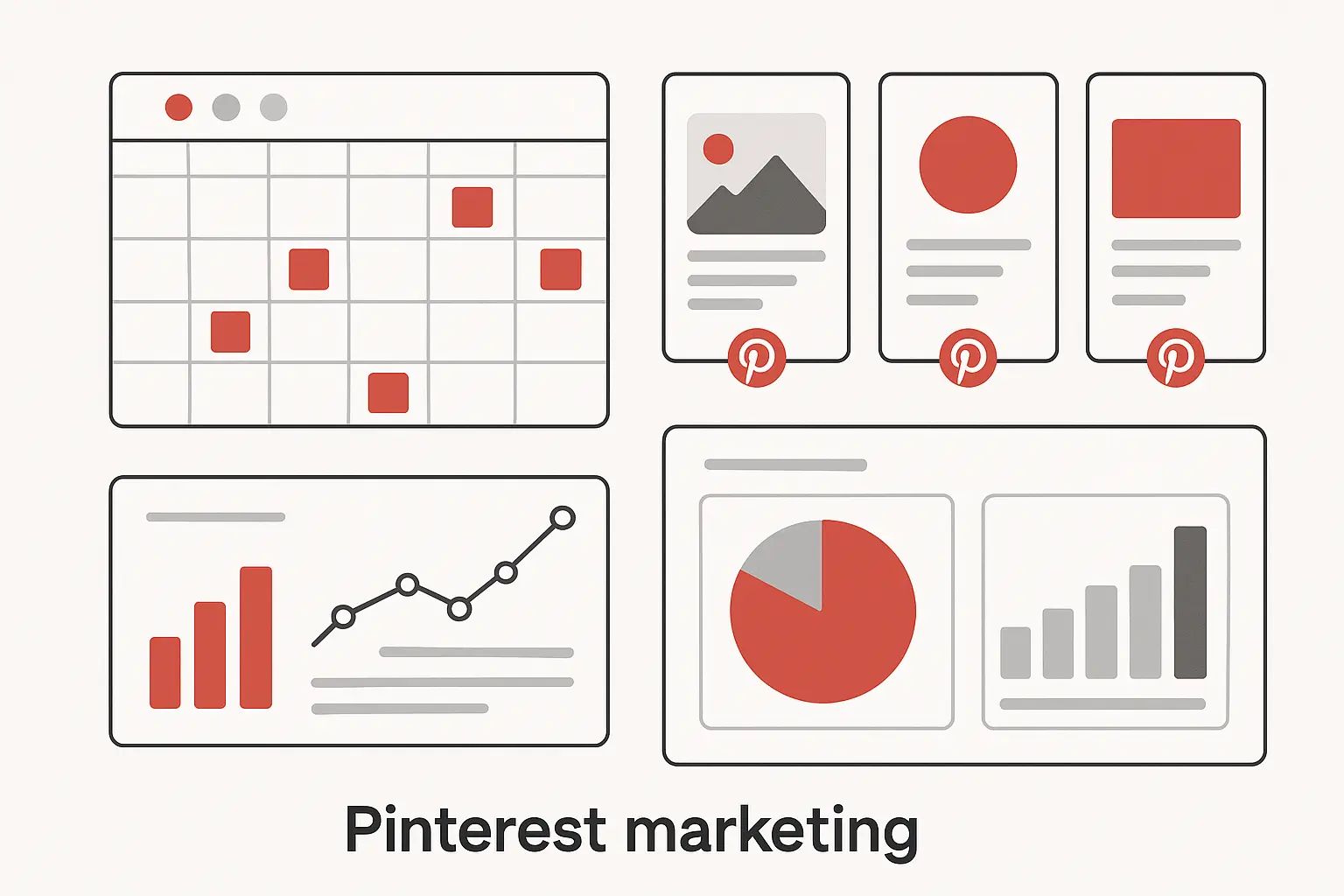
Creating Content That Actually Gets Found and Clicked
Alright, let’s get real about what actually works on Pinterest. I’ve tested hundreds of pin designs, and there are some non-negotiables that most people completely ignore.
First up: those vertical pins everyone talks about? They’re not just a suggestion – they’re practically mandatory. I’ve run split tests where identical content in different aspect ratios performed completely differently. The 2:3 vertical pins consistently get 2-3x more engagement than square posts. It’s not even close.
But here’s where most people screw up: they make their text too small or too fancy to read on mobile. Remember, most people are scrolling Pinterest on their phones while they’re bored or looking for inspiration. If I can’t read your pin title while I’m half-watching Netflix, you’ve lost me.
I always tell my clients to do the “mom test” – would your mom be able to read this pin while wearing her reading glasses and holding her phone at arm’s length? If not, make the text bigger.
Brand consistency matters more on Pinterest than other platforms because users often encounter your pins months after publication. Your visual style needs to be immediately recognizable even when users see your content outside the context of your profile or boards.
Pinterest Pin Optimization Checklist:
-
Use vertical aspect ratio (2:3 recommended)
-
Include clear, readable text overlay
-
Optimize image for mobile viewing
-
Use brand colors and fonts consistently
-
Include your logo or watermark
-
Test different design templates
-
Ensure image quality is high-resolution
The keyword research part is where things get interesting. Pinterest SEO is weird because people search differently here than on Google. On Google, someone might search “best running shoes 2024.” On Pinterest, they’re more likely to search “cute running outfit ideas” or “marathon training motivation.” It’s more emotional, more lifestyle-focused.
For businesses looking to maximize their Pinterest keyword research, understanding comprehensive SEO tool comparisons helps identify which platforms provide the best Pinterest-specific keyword insights and competitive analysis features.
Here’s my seasonal content reality check: I’m writing this in summer, but I’m already planning my clients’ holiday content. It feels insane, but Pinterest users start planning their Christmas decorating in September. If you wait until December to post holiday content, you’ve missed the boat entirely.
I learned this lesson when a client’s Valentine’s Day content got zero traction because we published it in February. Meanwhile, pins we created in November for the same holiday were still driving traffic months later. Now I have a giant calendar on my wall that’s always 2-3 months ahead of real life.
|
Content Type |
Optimal Publishing Timeline |
Peak Engagement Period |
|---|---|---|
|
Holiday/Seasonal |
45-90 days before |
30-60 days before event |
|
Fashion/Trends |
60-90 days before season |
During season transition |
|
Home Decor |
30-60 days before season |
Beginning of season |
|
Recipes/Food |
7-30 days before occasion |
Week of occasion |
|
DIY Projects |
30-45 days before need |
Weekends and evenings |
Pinterest content success requires treating the platform as a visual search engine with specific optimization requirements. Vertical images, clear text overlays, keyword optimization, and seasonal planning are essential components of effective Pinterest content strategy.
Understanding Pinterest Analytics (And What Actually Matters)
Pinterest Analytics can be overwhelming if you’re used to other platforms. The numbers work differently here, and honestly, some metrics that matter on Instagram or Facebook are basically useless on Pinterest.
Here’s what actually matters: saves over likes, every single time. When someone saves your pin, they’re essentially bookmarking it for later. That’s gold. It means they found your content valuable enough to come back to. Likes are nice, but saves indicate real intent.
The conversion tracking setup is crucial, but it’s also where most people give up. Pinterest’s tracking pixel works differently than Facebook’s because the user journey is so much longer. Someone might save your pin in January and buy your product in March. Traditional analytics would miss that connection entirely.
I had one client who was ready to quit Pinterest because her “immediate” conversion numbers looked terrible. But when we looked at the full customer journey data, Pinterest was actually her second-highest converting traffic source. People were finding her content on Pinterest, visiting her website multiple times, joining her email list, and then buying weeks later.
Pinterest users often save pins for future reference, creating a delayed conversion pattern that traditional analytics might miss. Users might save a pin in January and make a purchase in March, requiring attribution models that account for extended consideration periods.
Engagement metrics on Pinterest mean something different than on other platforms. High save rates indicate content that users find valuable enough to reference later, while click-through rates show immediate interest. Both metrics provide valuable insights, but they require different optimization strategies.
According to Niche Site Project, a Pinterest marketer saw their monthly viewers grow from zero to more than 123,000 in just 10 months, with Pinterest driving 66% of their social traffic.
The audience insights section is where you can really nerd out. Pinterest shows you what people searched for to find your pins, and this data is incredibly valuable for creating more content. If people are finding your “easy weeknight dinners” pin by searching for “quick family meals,” that tells you exactly what language your audience uses.
One thing that surprised me: Pinterest users are way more engaged than other social media users. They spend twice as long on websites they visit from Pinterest compared to other platforms. This isn’t just browsing – they’re actually reading, exploring, and considering purchases.
Pinterest Analytics requires different interpretation than traditional social media metrics because of the platform’s search-driven behavior and extended user journey patterns. Understanding these unique metrics helps optimize content strategy and measure true business impact from Pinterest marketing efforts.
Pinterest Advertising: What Works (And What Doesn’t)
Pinterest ads are a whole different beast, and I’ve wasted plenty of client money figuring out what works. The biggest mistake I see? Treating Pinterest ads like Facebook ads. They’re completely different animals.
First reality check: Pinterest ads need way more time to optimize. Facebook might give you decent data after a few days, but Pinterest ads often need 2-3 weeks to really hit their stride. I’ve had campaigns that looked terrible in week one but became top performers by week four.
The budget thing is interesting too. You can actually get started with smaller daily budgets on Pinterest – sometimes as low as $5-10 per day. But here’s the catch: you need patience. Pinterest’s algorithm is learning about your audience, and rushing the process with big budget increases usually backfires I learned this the hard way with an e-commerce client. We started with a $20/day budget, saw some promising results, and immediately bumped it to $100/day. Performance tanked. We scaled back down, let the algorithm learn for another week, then gradually increased spending. Much better results.
The targeting is where Pinterest really shines. Interest-based targeting works incredibly well because Pinterest users are actively engaging with content in specific categories. If someone’s constantly saving home decor pins, they’re probably genuinely interested in home decor – not just passively scrolling past it.
One targeting strategy that works really well: lookalike audiences based on your Pinterest engagers, not just your website visitors. Pinterest users who engage with your content are showing a specific type of intent that’s different from general website traffic.
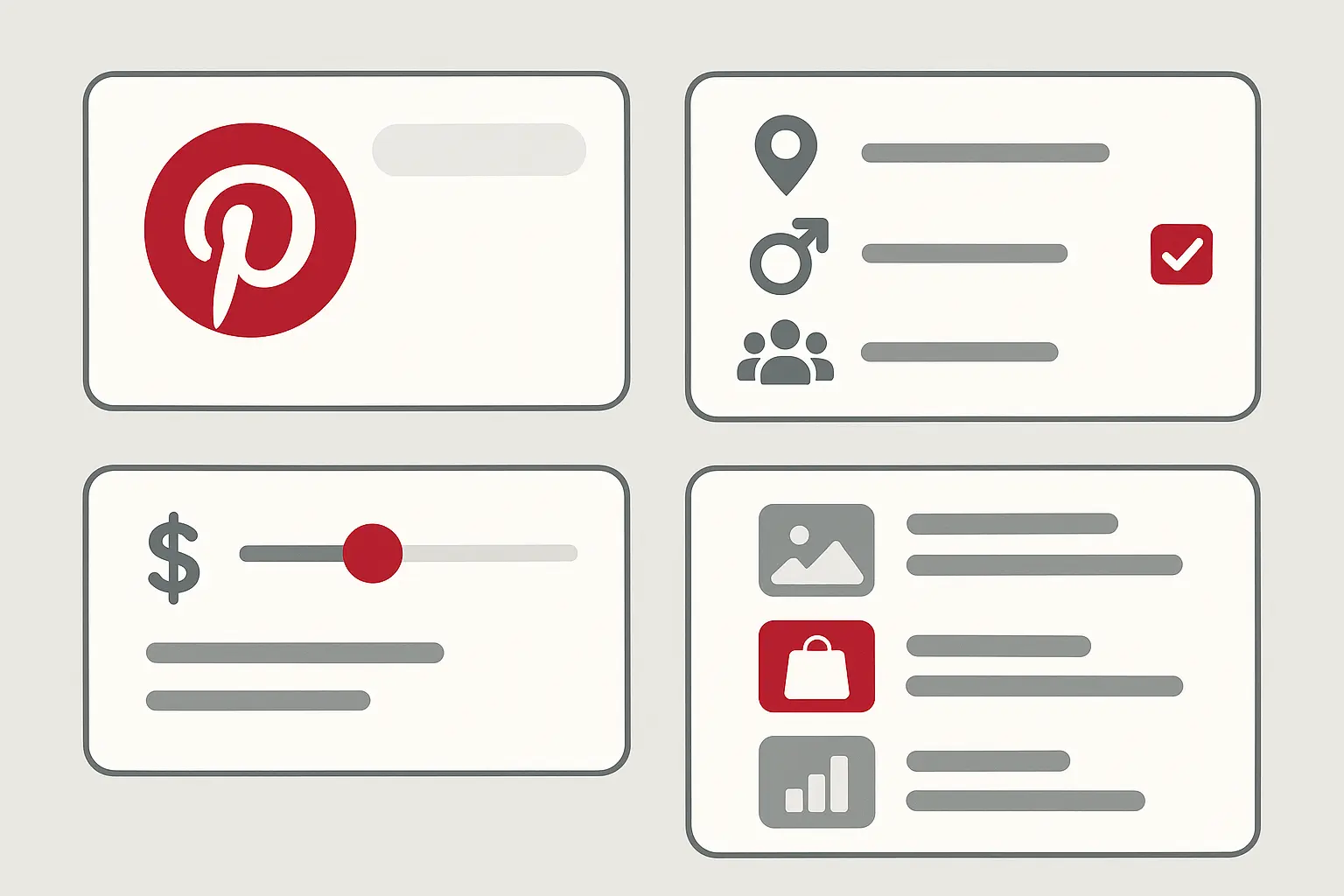
Pinterest advertising typically requires lower daily budgets than Facebook or Google Ads, but longer optimization periods to achieve stable performance metrics. The platform’s algorithm needs time to learn and optimize, so patience and consistent budgets often outperform aggressive spending increases.
Creative optimization for Pinterest ads follows the same principles as organic content: vertical images, clear text overlays, and value-focused messaging. However, ad creative needs to stand out in users’ feeds while still feeling native to the Pinterest experience.
For businesses managing Pinterest advertising alongside other paid campaigns, understanding marketing ROI calculations becomes essential for comparing Pinterest performance against other advertising channels and optimizing budget allocation.
Pinterest advertising success requires understanding the platform’s unique auction system and user behavior patterns. Lower budgets, longer optimization periods, and interest-based targeting often outperform traditional social media advertising approaches on Pinterest.
Integrating Pinterest Into Your Existing Marketing Mix
Turning Your Blog Content Into Pinterest Traffic Magnets
This is where I see the biggest missed opportunities. Most businesses have tons of blog content just sitting there, getting a tiny trickle of Google traffic, when they could be turning each post into 3-5 Pinterest pins that drive traffic for months or even years.
I worked with a personal finance blogger who had 200+ blog posts but was getting maybe 1,000 monthly visitors. We went through her top 20 posts and created Pinterest graphics for each one. Not just one pin per post – we created multiple angles. Her “How to Pay Off Student Loans Fast” post became five different pins: “Student Loan Payoff Plan,” “Debt Freedom in Your 20s,” “Stop Living Paycheck to Paycheck,” “Side Hustles for Loan Payments,” and “Millennial Money Tips.”
Same content, different hooks that appealed to different Pinterest search behaviors. Her traffic went from 1,000 to 15,000 monthly visitors in six months. Most of that growth came from Pinterest.
The key is understanding what blog content translates well to Pinterest’s visual format. How-to articles, listicles, and educational content work particularly well because they can be summarized visually while encouraging users to click through for complete information.
Creating multiple pins for each blog post maximizes reach and discovery opportunities. Different visual approaches to the same content can attract different audience segments and perform well in different seasons or contexts.
Blog-to-Pinterest Content Transformation Checklist:
-
Identify high-performing blog posts with visual potential
-
Create 3-5 different pin designs per post
-
Research Pinterest-specific keywords for each pin
-
Write compelling pin descriptions with keywords
-
Schedule pins across relevant boards
-
Track performance and optimize top performers
-
Repurpose seasonal content annually
Here’s a specific example: A marketing consultant had a blog post about “Why Most Small Business Marketing Fails.” We turned that into a Pinterest graphic titled “5 Marketing Mistakes That Are Killing Your Small Business” with each mistake clearly listed on the pin. That single pin drove more traffic to her website than the previous six months of social media combined.
The seasonal repurposing thing is huge too. That same student loan post? We created versions for “New Year Financial Goals,” “Back to School Money Tips,” and “Summer Side Hustle Ideas.” Same core content, different seasonal angles.
When developing Pinterest content from existing blog posts, applying proven blog topic research strategies helps identify which existing content has the highest Pinterest potential and conversion opportunities.
Converting blog content into Pinterest-optimized visuals can increase website traffic by 200-400% when done strategically. The key is understanding what content translates well to Pinterest’s visual format and optimizing for Pinterest-specific search behavior rather than assuming Google SEO principles apply directly.
Email Marketing + Pinterest: A Surprisingly Powerful Combination
Nobody talks about this combo, but it’s incredibly powerful. I discovered this accidentally when a client mentioned that her Pinterest followers were way more engaged with her emails than her other subscribers.
Here’s what’s happening: People who follow you on Pinterest are already interested enough in your content to actively seek it out. When they also join your email list, you’re getting super-engaged subscribers who actually open and click your emails.
I started testing this with several clients. We’d create pins that led to opt-in pages instead of directly to blog posts. The conversion rates were insane – sometimes 40-50% compared to 2-3% from other traffic sources. Pinterest users are already in that planning, research mindset, so they’re more willing to give you their email address for helpful content.
One food blogger created a pin for “30 Make-Ahead Freezer Meals” that led to an email signup for the complete meal planning guide. That single pin generated over 5,000 email subscribers in three months. Those subscribers had a 60% open rate compared to her usual 25%.
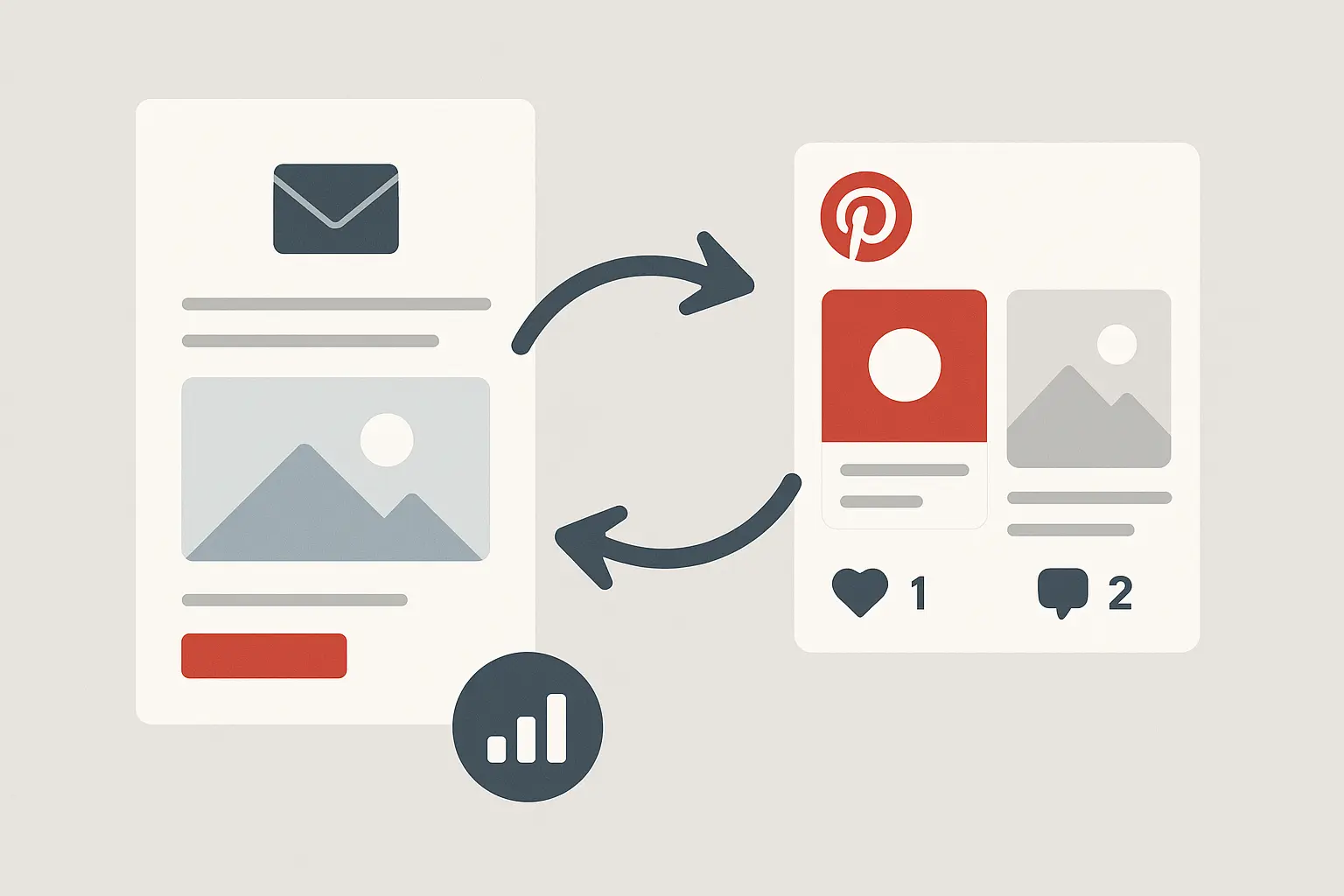
Cross-promotion strategies between email and Pinterest create multiple touchpoints with your audience. Email subscribers who also follow you on Pinterest show higher engagement rates and lifetime value than single-channel followers.
The visual consistency between Pinterest and email is important too. If your Pinterest brand is bright and colorful, but your emails are plain black text, you’re missing an opportunity to reinforce your brand recognition.
Seasonal coordination between email campaigns and Pinterest content amplifies the impact of both channels. Pinterest’s advance planning behavior complements email marketing’s immediate action focus, creating a comprehensive approach to seasonal marketing.
Integrating Pinterest with email marketing creates synergies that improve performance across both channels. Visual consistency, cross-promotion, and coordinated seasonal campaigns help maximize the impact of your marketing efforts while providing multiple touchpoints with your audience.
Case Study Analysis: How to Learn From Others’ Wins and Losses
Choosing Case Studies That Actually Apply to Your Business
Here’s where most people go wrong: they read a case study about some massive brand with a six-figure Pinterest budget and think they can replicate those results with $500 and a Canva account.
I learned this lesson early when I tried to copy a strategy from a major fashion retailer for a small boutique client. The fashion retailer was posting 50+ pins per day with a full design team. My client was a one-person operation trying to run her entire business. The strategy was completely unrealistic, and we wasted two months trying to make it work.
Now I’m way more selective about which case studies I pay attention to. I look for businesses that are similar in size, industry, and resources to my clients. A case study from a solo entrepreneur who grew their Pinterest following from zero to 100K is way more relevant for most small businesses than a case study from Nike.
Industry alignment matters because Pinterest performance varies significantly across different sectors, with home decor and food brands typically achieving 40-60% higher engagement rates than technology or financial services companies.
|
Business Type |
Ideal Case Study Focus |
Key Metrics to Evaluate |
Implementation Difficulty |
|---|---|---|---|
|
Small E-commerce |
Organic growth, seasonal content |
Traffic growth, conversion rates |
Low-Medium |
|
B2B Services |
Educational content, lead generation |
Lead quality, engagement rates |
Medium |
|
Large Retail |
Paid advertising, catalog integration |
ROAS, shopping pin performance |
High |
|
Content Creator |
Audience building, affiliate marketing |
Follower growth, click-through rates |
Low |
|
SaaS/Tech |
Visual tutorials, feature showcases |
Trial sign-ups, brand awareness |
Medium-High |
Budget alignment is crucial. If a case study doesn’t mention their advertising spend, team size, or time investment, I’m immediately skeptical. Real results require real resources, and any case study that makes Pinterest marketing sound effortless is probably leaving out important details.
Geographic and cultural factors influence Pinterest performance in ways that many case studies don’t address. US-based case studies show different user behavior patterns compared to European or emerging market implementations, so understanding your target market’s Pinterest usage patterns is essential.
Strategic objective matching ensures that case study insights align with your business goals. A case study focused on brand awareness metrics won’t help if your primary objective is driving direct sales conversions through Pinterest.
Selecting relevant Pinterest case studies requires evaluating industry alignment, company scale, geographic factors, budget considerations, and strategic objectives. Case studies that don’t match your business context often provide misleading insights that can lead to ineffective strategy implementation.
Reading Between the Lines: What Case Studies Don’t Tell You
Most Pinterest case studies are basically highlight reels. They show you the amazing results but skip over the months of testing, the failed campaigns, and the significant time and money investment that went into those wins.
I’ve been behind the scenes on campaigns that later became “success stories,” and the reality is always messier than the case study suggests. That “overnight Pinterest success” usually involved 6-12 months of consistent posting, multiple strategy pivots, and way more content creation than anyone wants to admit.
The timing factor is huge and almost never mentioned. A case study showing incredible results during Q4 (holiday shopping season) doesn’t necessarily indicate year-round performance potential. Pinterest traffic can be 3-5x higher during peak seasons, so those impressive numbers might not be sustainable.
I also pay attention to what metrics they’re highlighting. If a case study focuses only on follower growth or impressions without mentioning actual business results (traffic, leads, sales), that’s a red flag. Vanity metrics are easy to manipulate and don’t necessarily translate to business success.

Traffic and conversion attribution on Pinterest requires multi-touch analysis because of the platform’s research-oriented user behavior. Pinterest typically drives 3-5x longer session durations compared to other social platforms, but users often return multiple times before converting. Case studies that only show immediate conversion metrics miss this extended journey.
Here’s a reality check: I recently worked with a client who had 50K Pinterest followers but was getting less website traffic from Pinterest than another client with 5K followers. The difference? The second client had better content strategy and audience alignment, even though their numbers looked less impressive.
Recent success stories such as Pinterest’s partnership with Emma Chamberlain and Chamberlain Coffee, which received nearly 1,500 press mentions in the first week according to Axios, demonstrate how authentic brand partnerships can create multi-layered storytelling opportunities.
Pinterest case studies often omit crucial context about timing, resources, and measurement complexity that affects strategy replication. Understanding these hidden factors helps you set realistic expectations and adapt case study insights to your specific business situation.
Building Your Implementation Roadmap From Case Study Insights
When I’m helping clients implement strategies from case studies, I always break everything down into phases. Trying to do everything at once is a recipe for burnout and mediocre results.
Phase 1 is always foundation work, and it’s boring but crucial. Profile optimization, board setup, Pinterest Analytics installation – none of this is exciting, but it determines everything that comes after. I’ve seen too many businesses skip this step and wonder why their Pinterest strategy isn’t working.
Phase 1 foundation setup (weeks 1-4) focuses on Pinterest business account optimization, profile completion, board strategy development, and Pinterest Analytics installation with conversion tracking setup. This groundwork phase determines long-term success because Pinterest’s algorithm rewards accounts with complete, optimized profiles and proper tracking implementation.
The content creation phase is where most people either succeed or burn out. I usually recommend starting with 3-5 pins per week, not the 20+ pins per day that some case studies suggest. Consistency beats quantity every single time, and it’s better to post regularly for months than to post constantly for two weeks and then disappear.
Phase 2 content production and publishing (weeks 5-12) involves systematic content creation following case study best practices. Pin design optimization, description keyword integration, and strategic board organization require consistent execution over multiple weeks to generate meaningful data for optimization decisions.
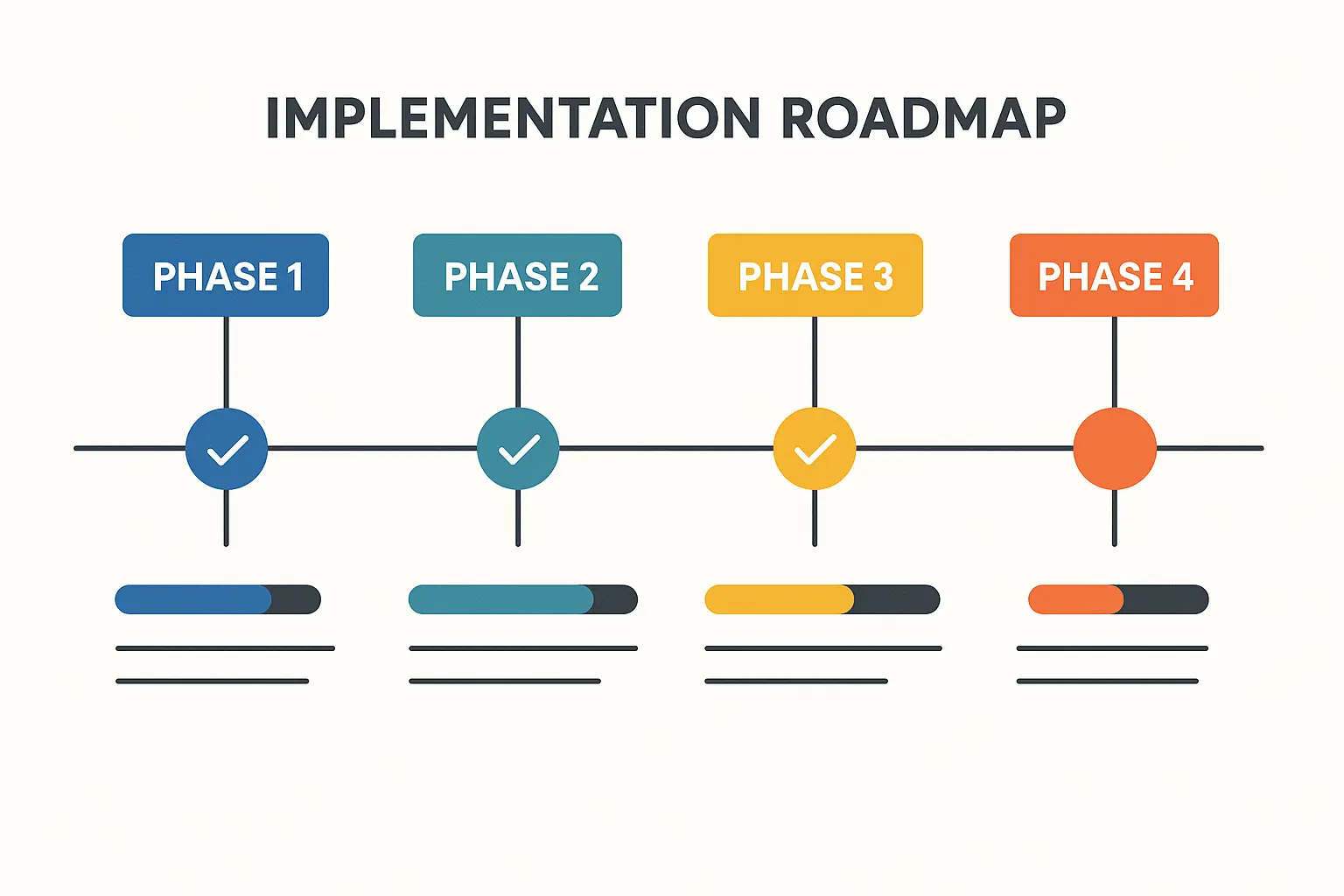
Phase 3 is where the real optimization happens, but only after you have enough data to make informed decisions. I see too many businesses making major strategy changes after one week of data. Pinterest moves slower than other platforms – you need at least 4-6 weeks of consistent activity before you can really evaluate what’s working.
Phase 3 performance optimization and scaling (weeks 13-24) focuses on data-driven refinement of successful tactics identified through case study analysis. Audience expansion, content format diversification, and advertising campaign launches should only begin after establishing baseline performance metrics and identifying what content resonates with your specific audience.
Pinterest Implementation Phase Checklist:
Phase 1 (Weeks 1-4):
-
Convert to Pinterest Business account
-
Complete profile optimization with keywords
-
Create 10-15 strategic boards with keyword-rich names
-
Install Pinterest Analytics and conversion tracking
-
Research competitor strategies and successful pins
Phase 2 (Weeks 5-12):
-
Create and publish 5-10 pins weekly
-
Optimize pin descriptions with target keywords
-
Test different visual styles and formats
-
Join relevant group boards in your niche
-
Monitor early performance metrics
Phase 3 (Weeks 13-24):
-
Analyze top-performing content and replicate success factors
-
Launch Pinterest advertising campaigns
-
Expand into video pins and story pins
-
Develop seasonal content calendar
-
Scale successful strategies
The testing cycles are crucial throughout every phase. What worked for the case study might not work for your specific audience, industry, or content style. I always build in time for experimenting with different pin designs, posting schedules, and content topics.
Implementing Pinterest strategies from case studies requires systematic phased execution with built-in testing and optimization cycles. Success comes from adapting proven tactics to your specific business context rather than copying strategies exactly as presented in case studies.
Final Thoughts
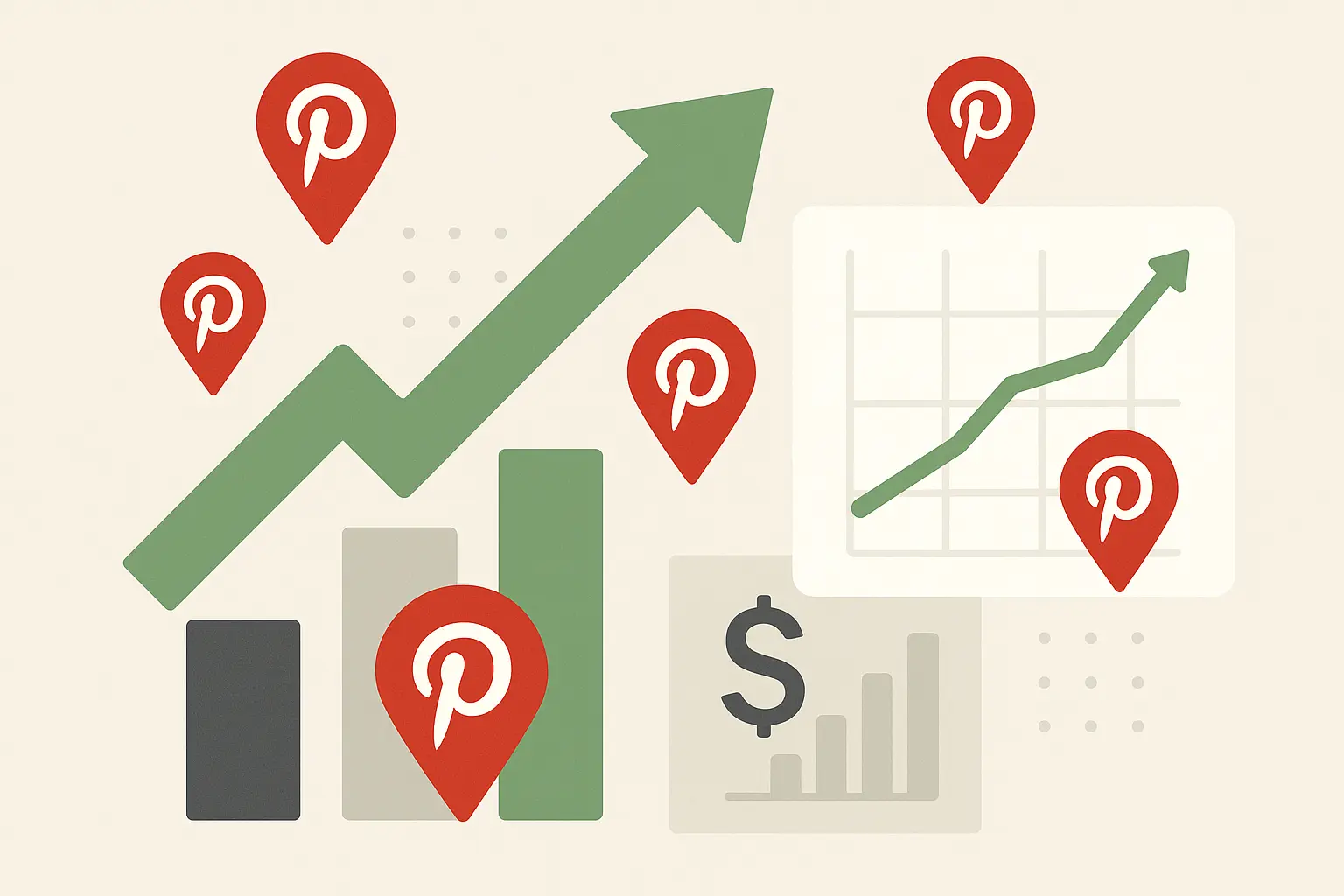
Look, Pinterest isn’t magic. It’s not going to save a failing business or replace a solid marketing strategy. But for businesses that understand how it works and commit to doing it consistently, it can be incredibly powerful.
The biggest mistake I see? Treating Pinterest like every other social platform. It’s not about going viral or getting likes. It’s about creating content that helps people plan, dream, and solve problems. When you nail that, the business results follow.
Pinterest case studies reveal a platform that rewards strategic thinking over random posting. The businesses seeing real results treat Pinterest as a visual search engine first and social platform second, optimizing for discovery and conversion rather than just engagement metrics.
After working with dozens of businesses on Pinterest over the past few years, the pattern is always the same: slow start, consistent effort, then suddenly everything clicks and traffic starts growing fast. The businesses that succeed are the ones that stick with it through the slow period and trust the process.
The most successful Pinterest strategies integrate with broader marketing efforts rather than operating in isolation. Whether you’re repurposing blog content, enhancing email campaigns, or building comprehensive seasonal marketing plans, Pinterest works best as part of a coordinated approach.
Implementation matters more than inspiration when it comes to Pinterest marketing. Case studies provide valuable insights, but success comes from systematic execution, consistent optimization, and patience with Pinterest’s longer conversion cycles. The platform rewards businesses that understand its unique user behavior and optimize accordingly.
If you’re just getting started, pick one thing from this post and focus on that for the next month. Don’t try to implement everything at once. Pinterest rewards consistency over perfection, and a simple strategy executed well will always beat a complex strategy executed poorly.
Pinterest’s evolution into a shopping destination and visual search engine creates opportunities that didn’t exist even two years ago. Businesses that adapt their strategies to leverage these new capabilities while learning from proven case study examples position themselves for sustainable Pinterest marketing success.



